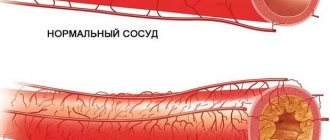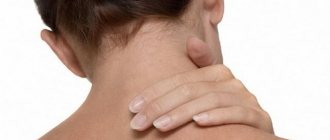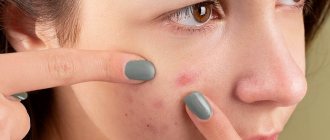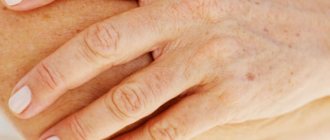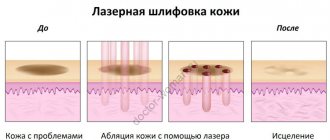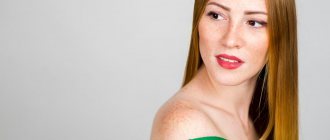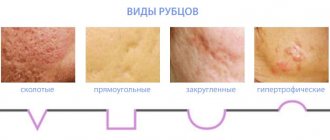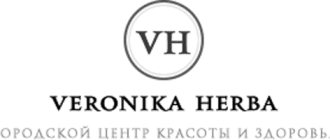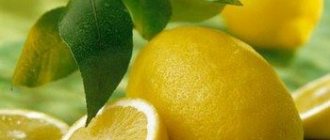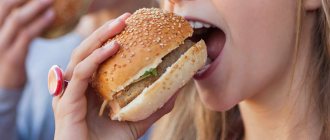What kinds of post-acne acne occur?
There are 3 types of post-acne, not only age spots:
- Scars are the most undesirable complication of post-acne
- Pigment spots – brown spots on the sites of former rashes
- Congestive erythema - redness accompanied by compaction from an unresolved element
All three types of post-acne can be present on the skin either simultaneously or separately, depending on individual characteristics and the tendency to develop pigmentation or scars.
How to remove acne spots with Fermencol gel
A specially developed Fermenkol line will help remove post-acne spots, aimed at correcting skin texture, normalizing color and restoring healthy tissue. All Fermenkol products contain 9 active collagenase enzymes, which “eat up” the destroyed vascular endothelium, improve local capillary circulation and, as a result, even out skin color.
Fermenkol also eliminates deformed collagen and, penetrating the dermis, acts only on pathological tissue, without affecting intact (healthy) areas of the skin. The result: clean, smooth skin without pigmentation.
To enhance the cosmetic effect, experts recommend using Fermenkol together with phonophoresis. The course of procedures can be completed either in a clinic at your place of residence or at home with a portable Reton device for phonophoresis. You can purchase Fermenkol products by placing an order online on the official website or in pharmacies in your city. Before use, consult a specialist; he will prescribe the optimal number of procedures. It is easy to get a consultation from a practicing doctor; to do this, you need to click the “doctor” button, describe your situation in detail and attach a photo of the damaged area.
Fermenkol products have already helped many people get rid of acne spots, here is just one of the reviews:
Remember! The sooner you start the course, the faster you will achieve the desired result and will again be able to enjoy healthy and beautiful skin.
The main predisposing factors for the appearance of post-acne
- Severity of acne – acne of III and IV severity often leads to complications, because affect the deep layers of the skin.
- Individual skin characteristics, genetic predisposition - such as dark skin color, a tendency to increase melanin production at the slightest inflammation or damage to the skin.
- Lack of treatment, inappropriate treatment, or late treatment is when the process has been present in the skin for a long time and has affected deep tissues.
- Skin injuries during mechanical cleaning, i.e. when roughly squeezing out pimples.
The presence of at least one predisposing factor may be the cause of the development of post-acne.
Forms and symptoms
Acne can visually manifest itself in quite different ways and occur in mild, moderate and severe forms. Therefore, many patients may not even realize that they have this dermatological disease. Symptoms of acne may include:
- open and closed comedones;
- milia - white dense acne, resembling grains, usually painless (most often located under the eyes and on the upper eyelids, less often on the forehead, cheeks, cheekbones);
- oily hair;
- papulopustular elements and nodes, which are often very painful;
- peeling of the skin or, conversely, the presence of an oily sheen.
Modern classification involves dividing all cases of acne into juvenile acne, adult acne, childhood acne, including newborns.
Depending on how acne manifests itself, there are 3 main forms:
- comedonal;
- papulopustular;
- conglobate.
At the same time, starting with the appearance of open and closed comedones, acne can eventually transform into a papulopustular rash, etc. Therefore, these forms are considered as stages of the disease. In mild forms of the disease, single comedones, papules and/or pustules are observed. In the moderate form, in addition to these single elements, single nodes are attached, while in the severe form, multiple papules and pustules, as well as conglobate nodes, are observed.
Comedonal form
This form is characterized by the formation of blackheads or comedones, which is considered as the first stage in the development of acne. Its signs can appear as early as 8-year-old children and initially consist of increased oiliness of the skin and hair. Over time, small comedones begin to form at the mouths of the sebaceous glands, which tend to transform into closed comedones. These are the same painless and non-inflamed blackheads that can appear as small bumps of normal skin color and with a white protruding tip of sebum.
Comedones often cannot resolve on their own, since the thickened walls of the mouths of the sebaceous glands prevent the arbitrary removal of accumulated secretions out. Since the sebaceous gland, despite the blockage of its duct, continues to function and produce new portions of sebum, its walls gradually stretch, and the pressure on them increases in direct proportion to the amount of accumulated sebum. This causes the formation of papules and pustules, i.e. the development of the papulopustular form of the disease.
Papulopustular form
This form is already characterized by the formation of papules and pustules against the background of the presence of open and closed comedones, as well as traces of resolved elements on the skin (post-acne), and their number directly depends on the severity of the disease. Papules are dense or soft formations that rise above the surface of the skin. At the same time, pustules mean formations rising above the surface of the skin with clearly visible white contents.
Often, with papulopustular acne, rashes are observed not only on the face, but also in the décolleté area, as well as on the back.
Acne conglobata
The conglobate form of acne is considered the most severe. It is characterized by the formation of large elements that rise greatly above the level of the skin and can reach large sizes and merge with each other. Conglobate acne is dense to the touch and very painful on palpation. They can form both on the face and on other parts of the body. But they are more often found on the back.
Conglobate acne can exist for months without opening. But if this does happen, long-term non-healing ulcers form in their place, leaving deep scars.
How to avoid age spots and scars
- Start acne treatment immediately. Even mild forms cannot be ignored - grade 0-2 acne, when there are single elements on the skin.
- Don't push! A banal but difficult point to implement. Skin cleansing can be done and sometimes even necessary, but it should be done carefully and competently by a cosmetologist.
- Use medications with anti-inflammatory effects. Not to be confused with antibacterial! Anti-inflammatory drugs have both preventive and therapeutic effects.
Recommendations follow from the previous paragraph - exclusion of predisposing factors.
List of effective acne remedies
Effective medications for rashes cope well with epidermal disorders, do not have negative effects when used correctly, have a small number of contraindications and are well accepted by the skin, without clogging pores or leading to allergies.
Below is a review of the best facial acne treatments for teenagers and adults .
Salicylic ointment
The composition of the medicine includes salicylic acid and petroleum jelly. The substances exhibit a pronounced anti-inflammatory and antiseptic effect. Suitable for treating purulent rashes and lightening the skin after acne. Salicylic ointment is used for no more than 21 days.
Restrictions on use: kidney pathologies. The product has an exfoliating effect and is often used for acne scars. The ointment causes a burning sensation, increases local blood flow, thereby regenerating skin cells.
Heparin ointment
The product contains heparin, benzocaine, and benzyl nicotinate. Healing ointment is indicated for the treatment of comedones and acne. Helps relieve inflammation and has an analgesic effect.
The course of treatment is 2 weeks.
Cannot be used by pregnant or lactating women.
Zinc ointment
The main substance is zinc oxide. Disinfects and perfectly dries purulent rashes, removes acne. Under its influence, traces of acne instantly resolve, and the ulcers themselves dry out, leaving no scars.
Contraindications for use: individual intolerance and allergic reaction to the ointment.
Akriderm
Indications for the use of Akriderm are skin pathologies, including comedones, blackheads, pimples, acne. Hormonal ointment, the main element is glucocorticosteroid betamethasone. This pharmaceutical acne remedy has an anti-inflammatory, anti-edematous effect.
Requires caution in use, as addiction is possible. It is forbidden to apply to large areas of skin and mucous membranes.
Akriderm - various ointments and creams - Genta, GK, SK. A one-component product is sufficient, but if:
- a bacterial infection has joined - the choice of drug is gentamicin and betamethasone - Akriderm Genta;
- a fungal infection occurred - Akriderm GK.
Tetracycline ointment
The antibacterial agent contains a powerful antibiotic - tetracycline. Intended for therapy:
- extensive skin rash;
- effective against purulent acne on the shoulders, eyebrows, head;
- boil;
- trophic ulcers.
Prescribed only if weaker antibiotic ointments do not produce results.
Contraindications: mycosis, children under 12 years of age.
Tetracycline ointment is inexpensive, only 15-20 rubles.
Ichthyol ointment
This is a powerful remedy for facial rashes. The element ichthyol included in the composition creates complex therapy. Black ointment instantly removes inflammation and pain that appears from internal acne. The medication is precisely distributed to the pathological area to accelerate maturation.
Directions for use: 1 time per day until the rash disappears completely. Ichthyol ointment is also used against boils.
The limitation is sensitivity to Vaseline.
Vishnevsky ointment
Birch tar and xeroform are natural components of the medicine. Substances exhibit:
- antiseptic, absorbable seal action;
- ointment accelerates the maturation of ulcers;
- Castor oil softens the epidermis and promotes rapid healing.
The only contraindication: individual intolerance.
Baneocin
The antibacterial complex drug is suitable for the treatment of acne and folliculitis. The active substance is bacitracin, neomycin sulfate. An anti-inflammatory ointment with an antibiotic removes diseases caused by pathogenic microorganisms.
The affected area is treated three times a day for 7 days.
Do not use for severely damaged skin.
Hydrocortisone
Glucocorticosteroid relieves swelling, itching and inflammation. Indicated for non-bacterial skin rashes.
Instructions for use: 2 times a day (morning and evening). The duration of treatment is 1-2 weeks, if necessary, you can take a 3rd week.
Restrictions on the use of the medicine are:
- infection of the epidermis by viruses, bacteria;
- younger age up to 2 years;
- pregnancy period, lactation.
Methyluracil
The main element is methyluracil, aimed at accelerating metabolism in skin tissues. The healing agent provides:
- antiseptic, antibacterial effect;
- relieves inflammation, swelling;
- strengthens the immune system.
The medicine is prescribed for acne, boils, diaper rash, carbuncle, and is also effective in the presence of subcutaneous mites.
We previously wrote about methyluracil suppositories in more detail - we recommend that you read it.
Therapeutic ointment is not recommended for use by pregnant women, women during breastfeeding, or with allergies to lanolin, paraffin, or cancer.
This remedy for acne on the face can be bought at a pharmacy for 30-80 rubles. for the tuba.
Streptocide ointment
Antimicrobial drug with a wide spectrum of effects. It kills streptococcal type bacteria. Relieves inflammation, pain, increases the process of maturation of rashes.
Indications for use: wounds, cuts, erosions, ulcers, erysipelas.
For subcutaneous acne, streptocide is best used in tablet form, crushed and applied as a compress.
Synthomycin
The cleansing product has an immediate effect. Chloramphenicol – the main component relieves inflammation. Intended for the treatment of ulcers, small spots, acne. The antibiotic kills microorganisms that cause acne.
We wrote more about this ointment in our article.
Contraindications for syntomycin ointment:
- liver, kidney failure;
- psoriasis, eczema;
- fungal skin pathologies;
- acute porphyria.
The spot remedy is applied to the pathological area. The duration of treatment is no more than 5 days.
This is a relatively inexpensive remedy for acne - you can buy it at a pharmacy from 76 rubles.
Clotrimazole
An antifungal drug fights inflammation in various parts of the body, acne. Beneficially removes acne marks and age spots.
The only limitation to the use of the ointment is skin hypersensitivity to its constituent components.
The gel is used for a month.
It may be interesting: The most effective remedies for toenail fungus.
Advantan
The active ingredient - methylprednisolone, prevents accelerated cell division, eliminates redness, itching, swelling, and rashes. It is an antiallergic agent.
Indications for use are as follows:
- childhood eczema;
- acne in teenagers;
- seborrhea, exogenous pathologies.
Therapeutic course: 1 time per day for 1 month. in children. The duration of treatment in adult patients is no more than 3 months.
Elon
Oil and larch extract are the main substances that help cope with purulent rashes. Elon ointment effectively draws out pus and relieves inflammation.
The herbal product has almost no contraindications, except for personal intolerance to the constituent components.
The cost of the medicine is 300-600 rubles, it can also be ordered through the online store.
Sinaflan
The active substance is fluocinolone acetonide. The effect of the ointment is as follows: it exhibits antipruritic, decongestant results. Suitable for the treatment of typical and atypical types of rashes. Available in the form of cream and gel.
Sinaflan cannot be used if you have:
- bacterial infection (pyoderma);
- papular acne with syphilis;
- skin tuberculosis.
Adapalene
The dermatotropic agent has an anti-inflammatory, sebostatic effect. The substance Adapalene is used for acne and blocks the development of comedones.
The drug is effective:
- softens dead skin areas, preventing their transformation into keratinized tissue;
- protects the epidermis from the introduction of infectious pathogens.
The therapeutic effect occurs gradually, after about 2-3 months.
Pimafukort
Antifungal, anti-inflammatory, antibacterial express remedy. Indicated for pyoderma, mycoses, superficial dermatoses.
Fucidin
The best bacteriostatic drug, suitable for men and women. Helps cure cystic fibrosis, acne, boils.
A fast-acting antibiotic should be used up to 5 times a day.
Rescuer
A popular regenerating ointment with a softening effect. Prevents the appearance of scars and skin pits after acne, relieves pain, tightens wounds.
The balm has received a high rating on the Internet because it is an inexpensive and effective remedy.
Sulfuric ointment
Consists of precipitated sulfur, has an antimicrobial, drying effect. Helps well with:
- rash;
- subcutaneous acne;
- inflammation during a cold;
- skin parasites.
Use for about 3 weeks.
Baziron
Baziron is a proven ointment for rashes, suitable for dry skin. The medicine produces:
- antibacterial effect;
- corrects sebum secretion;
- pleasantly moisturizes the epidermis.
Effective against acne, juvenile acne, rashes.
Duration of use – 3 months.
Argosulfan
Silver sulfanilamide is the active substance. Argosulfan is an antimicrobial bacteriostatic drug. Suitable for the treatment of purulent wounds, acne, bedsores.
The cream should be applied to the painful area until the wounds are completely healed, but no more than 2 months.
Stellanin
The active ingredient is diethylbenzimidazolium triiodide. The new product kills pathogenic organisms and fungi.
Contraindications: hyperthyroidism, thyroid tumors.
Stellanin is a combined natural ointment. Use: burns, peptic ulcers, bedsores.
Oflomelid
Methyluracil, Lidocaine hydrochloride, ofloxacin - the medicine has 3 main substances. It has an antimicrobial, regenerating, analgesic effect, and helps speed up the healing process.
Prescribed for the following processes:
- trophic ulcers;
- abscess boils;
- removes white rods located in a pimple wound;
- fistulas
Oflomelid should not be used if you are under 18 years of age or if you are pregnant or breastfeeding.
Nystatin
The antifungal antibiotic exhibits a fungicidal effect. Used for stomatitis, candidiasis, diaper rash, mycoses.
Directions for use: apply as a compress at least 2 times a day for 14 days.
Fenistil gel
The 0.1 percent emulsion is suitable for the treatment of both teenage and adult acne, comedones, blackheads, blackheads on the back and face.
Therapeutic effect:
- antipruritic;
- soothing;
- antiallergic;
- anti-bradykinin.
Contraindications: prostatic hyperplasia, sensitivity to dimethindene.
Gentamicin ointment
Used in cosmetology and medicine, treats acne, fungal dermatitis, seborrhea. Does not affect fungi or viruses.
Negative manifestations: hematopoiesis disorder, malaise, weakness, headache.
Retinoic ointment
Skin care cosmetics are effective against acne, blackheads and prevent the appearance of wrinkles in women. The ointment increases blood circulation and renews skin cells. The effect of the drug is uncertain and can lead to irritation of the epidermis, redness, and burning.
Erythromycin ointment
Used in combination with other medications. The active component of erythromycin ED copes favorably with purulent rashes, wounds, burns, and conjunctivitis.
Therapeutic course – 1 month.
Levomekol
The product is intended to eliminate rashes and ulcers. For teenagers - an excellent salvation, removes painful acne on the face and forehead.
Chloramphenicol, methyluracil – active ingredient:
- relieves inflammation;
- has an antimicrobial effect;
- dries out the skin.
Treatment should be carried out for no more than 1 month.
Lincomycin
The antibiotic removes erysipelas, pyoderma, felon, furunculosis, and purulent rash. Active ingredient: zinc oxide, lincomycin hydrochloride. Not used for renal or liver failure.
Gistan
The cosmetic product eliminates allergic rashes, relieves inflammation, relieves symptoms of the disease, regenerates the skin, and blocks the production of histamines.
Comfoderm
Methylprednisolone aceponate is the active substance. The ointment treats:
- eczema;
- dermatitis;
- inflammatory skin pathologies;
- Suitable for acne spots.
Features of use: do not exceed therapy for children for more than 28 days, for adults - 3 months.
Boromed
Antiseptic cream reduces swelling and inflammation, soothes the skin, dries out ulcers, has a resolving effect, prevents the formation of irritations after shaving, and smoothes out fine wrinkles.
Contraindicated in children under 12 years of age.
How to get rid of post-acne
Recommendations of the International Society of Dermatologists and Cosmetologists: 1st line drugs for acne and post-acne treatment are retinoids .
- Have an anti-inflammatory effect;
- Normalize the functioning of pigment cells, lighten pigment spots;
- Normalizes the functioning of the sebaceous glands. With acne, the amount and composition of sebum changes - the main reason for the development of acne;
- Increase local immunity, which helps fight inflammation;
- Stimulate the synthesis of collagen necessary to fight scars.
Due to such a wide range of cosmetic effects on the skin, retinoids are recognized as the gold standard for the treatment of acne and post-acne.
The result of using retinoids:
- lightening pigment spots
- smoothing skin texture
- reduction of scar depth
Retinol benefits:
- Physiological – is a substance familiar to the skin, because the body itself supplies vitamin A to the skin in low concentrations;
- Has no toxic effect;
- Suppresses the increased activity of melanocytes, without destroying them, but normalizes melanin production;
- Penetrates well into the skin, reaching the necessary layers;
- Stimulates cellular renewal, preventing colored cells from remaining on the surface, and accelerates their exfoliation.
Methods of treating post-acne in a cosmetology clinic
To get rid of the problem, our clinic uses different methods and their combination.
Chemical peeling
It is carried out with fruit, azelaic and salicylic acids. The action of peeling is aimed at reducing hyperkeratosis (excessive growth of the stratum corneum of the skin). The higher the acid concentration in the peeling solution, the more noticeable and sensitive the exfoliation will be. As a result of the procedure, the boundaries between healthy skin and scars are smoothed, and the process of restoration (regeneration) of the tissues at the bottom of the atrophic scar is activated.
Mesotherapy
The essence of the mesotherapy procedure is the subcutaneous administration of compositions of several medicinal substances or single drugs. The components are phospholipids, magnesium and silicon salts, polylactic acid, which improve the quality of the skin and activate regeneration and repair processes.
Also used: enzymes, vitamins, antibiotics, antioxidants, biorevitalizers, corticosteroids, immunomodulators and other biologically active substances.
Plasmolifting
Plasmolifting is the introduction of platelet plasma obtained from the patient’s own blood into the deep layers of the dermis. The complex treatment method helps to effectively deal with scars caused by acne. First, the doctor carries out controlled damage to the upper and middle layers of the skin, using laser or chemical peeling and grinding. This accelerates the synthesis of new skin cells. In this way, scar tissue is replaced with healthy tissue. The second stage is plasma lifting itself, which activates regeneration and accelerates skin restoration.
Laser therapy
A highly effective method of getting rid of post-acne, the manifestations of which cannot be eliminated by other means. In the clinic, treatment is carried out with 2 types of laser: Picosure (fractional non-ablative effect) and carbon dioxide Eraser-C RF (laser ablative resurfacing). The most widespread is laser resurfacing using a CO2 laser. With this therapy, sufficient (from 50% to 80%) clinical improvement in the scar area is recorded after just one procedure. Efficiency increases due to the activation of collagen synthesis. When radiation is absorbed by the skin, they heat up, after loss of fluid, the cells are destroyed, tissue coagulation occurs, the destruction of old elastin and protein is gradually replaced by new structural elements. The duration of the procedure is determined by the type of laser and the amount of intervention required. It can range from 15 to 90 minutes.
Can acne spots go away on their own?
Post-acne pigmentation and stagnant spots do go away on their own, but for how long is another question.
If we talk about post-acne pigmentation, then its “lifespan” depends on the amount of pigment and how deep it is located, because the pigment leaves during the renewal process along with skin cells.
Erythema, in turn, goes away faster. But the longer and stronger the inflammation, the slower the stagnant spots will disappear.
This is actually why no one can say exactly how long it will take: it could be 3 weeks or several years (in the case of pigmentation).
Types of acne marks
Acne marks most often involve hyperpigmentation (normal areas of the skin alternate with darker ones). Stagnant red spots, enlarged pores filled with sebum, or pathological scars may also appear. When the excretory duct of the sebaceous glands is blocked, atheromas (cysts filled with fat) or milia (whiteheads) develop.
Old scars and scars after purulent acne are divided into the following forms:
- dimples, isolated fragments of skin (atrophic);
- lumps, convex lesions accompanied by erythema (hypertrophic);
- certain areas of the skin have increased pigmentation (dyschromia).
Most often, post-acne appears in the form of atrophic scars. They can be round, square or chipped in shape. The first two types can be eliminated quite easily. And chipped ones are the most problematic, since their base is localized deep in the dermis.
Forecast. Prevention
Colloidal scars are the most difficult to remove. Destructive methods are contraindicated here, that is, such defects cannot be excised, scraped, burned, or sanded. Otherwise, even more serious consequences may arise. Therefore, it is important not to bring the post-acne problem to such a state.
The main rule is to treat acne promptly and competently to prevent complications.
If after acne you have a stagnant spot
, your task is to prevent it from developing into a scar. To do this, you need to care for your skin in a special way.
- Do not subject the stain to rough physical, chemical, or mechanical stress
so as not to damage it. Minimum 3 months. - Don't stay in the sun for long periods of time.
- Moisturize your skin.
If you prefer pharmaceutical products, choose those that contain zinc hyaluronate (Curiosin, Regetsin, etc.).If you are one of the fans of natural cosmetics, pay attention to Beauty365 products.
To moisturize during the day and cleanse the skin, choose light and soft products - hydrolates (water distillates). It is best to stop at Beauty365 mint hydrolate and Beauty365 sage hydrolate - they “specialize” in oily and problematic skin.
Enhanced hydration and regeneration will be provided by Beauty365 squalane (sugar cane) and Beauty365 sasanqua camellia oil. Natural vegetable oils are the best way to soften rough skin. Camellia sasanqua will also help whiten stains.
- If you need to relieve inflammation, use a special remedy.
For example, ichthyol ointment (20%) is suitable. Within two weeks of use, the redness will subside.
If scars have already begun to form
, then you can lubricate them with ointment containing silicone dioxide or polysiloxane. It will create a film that will reduce fibroblast activity and collagen production.
Azelik® is a drug for the treatment of acne
Azelik® is a gel based on azelaic acid. The foundation also contains an auxiliary component - the emollient squalane, which helps moisturize and soften the skin2,7. Azelik® helps reduce the level of free fatty acids on the skin and normalize keratinization processes in the follicles5. By reducing the metabolism of neutrophil granulocytes and their production of free radical forms of oxygen, the inflammatory process is reduced5.
